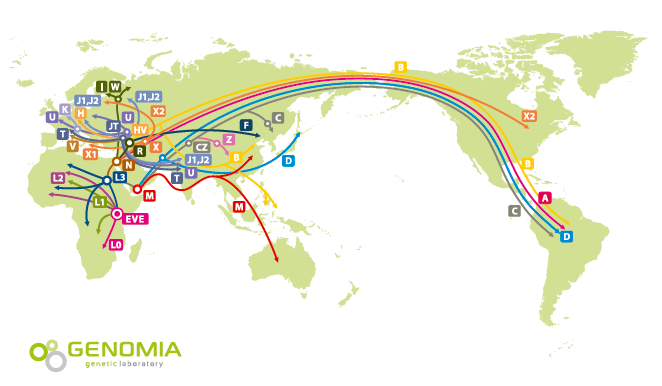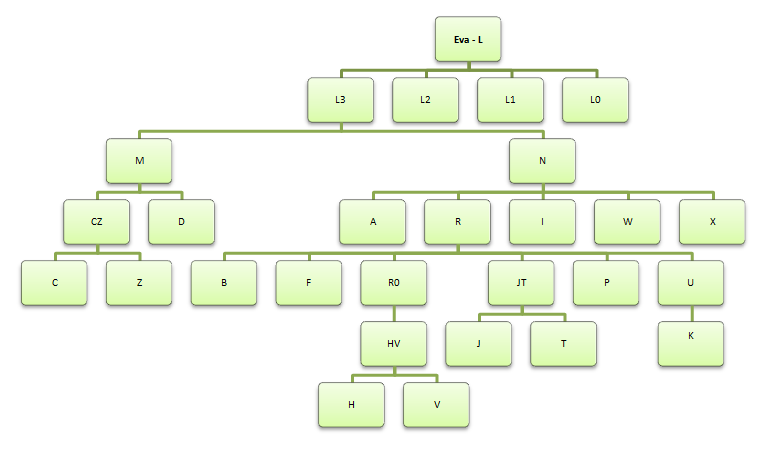
Maternal line
The genetic analysis of conserved regions of mitochondrial DNA (mtDNA) can discover the origin of maternal line. The research has shown that all known maternal lines have origin in one genetic foremother Eve. The mtDNA of the ancient foremother has undergone a series of mutations during the evolution and based on these typical (today conserved) mutations, persons are matched to one of 22 basic haplogroups.
The mtDNA is transferred from mother. It is inherited by both sons and daughters, but only daughters are able to pass it on to their children. Sons are a blind branch and they do not transfer the information stored in their mtDNA to their descendants. The genetic mtDNA test can be performed both in men and women. The result of genealogical DNA test is the determination of the haplotype (statement of decisive markers) and matching to specific haplogroup.
Genomia performs tests of maternal line HVR I and HVR II (i.e. identification of regions in the sequence of mitochondrial DNA: HVR I base 16024 - 16548, HVR II base 3 – 423). The basic test is HVR I that enables to match a person to the relevant haplogroup, i.e. maternal clan. The HVR II region is a supplementary test; it can help in some persons to specify his/her haplogroup.
Thanks to mtDNA, everyone alive on the planet today can trace their maternal ancestry back to just one woman, the common genetic foremother Eve who lived in East Africa approximately 80 thousand years ago (the time information differs in various literatures). The descendants of this ancient foremother moved from Africa worldwide through time. The migration routes are shown on the map:
Current haplogroups
From the mtDNA of every individual it is possible to identify the closest haplogroup on the maternal line. It can be determined the geographical origin of each person in the maternal line – so-called maternal clan. We know, from where the clans migrated and their genetic age and where in the world live the descendants of the same clan. There have been identified 22 basic haplogroups (clans) worldwide, seven of them occur mostly in Europe. Bryan Sykes in his publication The seven daughters of Eve, published in 2004, presented the seven European haplogroups and invented women´s names for them:
- Haplogroup U: Ursula
- Haplogroup X: Xenia
- Haplogroup H: Helena
- Haplogroup V: Velda
- Haplogroup T: Tara
- Haplogroup K: Katrine
- Haplogroup J: Jasmine
Other non-European haplogroups are:
- Africa L0, L1, L2, L3
- America: A, B, C, D
- Australia: M
- Asia: F, G, I, N, R, W, Z
The following picture shows the progressive evolution of haplogroup from mtDNA since the foremother Eve:
Genealogical database
There are a number of genealogical databases. In mtDNA databases, you can find many persons with identical sequence of mtDNA. However, from these identical sequences you cannot draw conclusions about family relationship of the persons. Based on mtDNA analysis, it is however possible to determine the geographical region, where the given haplogroup lived. The databases are freely accessible and upon entry of your haplotype you can find other individuals with identical haplotype all over the world.
- www.mitosearch.org
- Sorenson Molecular Genealogy Foundation - Mitochondrial database
- Family Tree Builder
- www.isogg.org
Note: Into the My heritage database, it is possible to import only the results of SNP profiles, while the YSRE and MtDNA analyses cannot be imported. The SNP profile of a person is determined by whole genome sequencing. It is a completely different technology than STR analysis or direct sequencing of HVR regions.
Other information
Learn more also about the paternal line!
How much does the genealogical test cost?
Thanks to Y-DNA every man alive today can trace his origins to one common genetic forefather Adam who lived in East Africa about 80 thousand years ago. The descendants of this one common ancestor left East Africa over time and migrated around the world.
More information
Take a look at our price list and order the selected test and DNA collection kit for the testing.
More information





